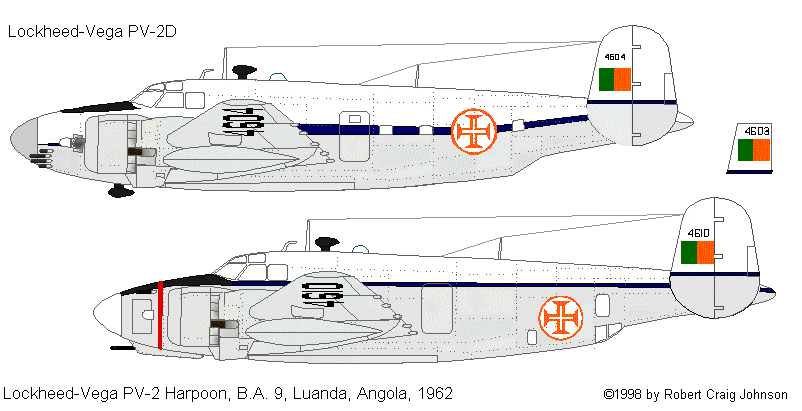
When the Portuguese arrived in Africa late in the 15th century, they were the first European colonial power to establish itself on the continent. When they left in 1974, they were among the last to leave. The last fifteen years of this long and unhappy sojourn were marked by unrelenting guerilla warfare throughout the African colonies. Portugal was ruled by a dictatorship that dated back to the 1920s. Faced with monetary, diplomatic, and human costs that no small, relatively poor country could long bear and with the seeming success of France's operations in Algeria before it, Portugal's saw aviation as the key to the preservation of its overseas territories and its claims to a place among the world's first-rate powers.
Portugal was something of an accidental colonial power in Africa. Portuguese sailors first stopped in Africa for water during their great trading voyages to the Orient. They returned for slaves, a traditional feature of the African economy that could be used to fill the labor needs of Portugal's Brazilian plantations. The slaves were supplied by a powerful, native kingdom, Bakongo, in what is now northern Angola and far southwestern Congo. At first, Bakongo could meet the demand by selling prisoners of war it had taken in day-to-day disputes with its neighbors. But the swelling demand from Brazil soon depleted the supply of prisoners and forced Bakongo into more and more wars. As the number of its enemies grew, Bakongo needed more modern weapons, especially guns, which in turn had to paid for with still more slaves. It was a vicious circle. Inevitably, the Bakongo state became over-extended, suffered reverses on the battlefield, and suffered dissension at home. Within 50 years or so, the kingdom had collapsed and its great cities had been swallowed by the jungle. Almost reluctantly, Portugal took charge of the country in order to protect its watering stations and its source of slaves. The Portuguese made little attempt to colonize the territory, and, as the demand for slaves waned and the routes to the East lost their crucial importance in the world economy, the colonies gradually lost their importance to the home country. By the middle of the nineteenth century, all but autonomous.
So things stayed until the early 1930s. In May 1926, rightwing army officers overthrew the Portuguese government and, in 1932, installed António Salazar as de jure prime minister and de facto dictator, a position he retained until 1968. Salazar had a rather old-fashioned notion of what constituted the wealth of nations, and his single-party New State and infamous secret police (Polícia Internacional de Defesa de Estado or PIDE) saw to it that he never heard anything more up-to-date. For Salazar, colonies were what made a modern nation great. Colonies provided captive markets for home-produced goods, ready sources of cheap raw materials and foodstuffs, and an outlet for the homeland's surplus population. Accordingly, from 1930 on, Salazar did all he could to integrate the African colonies into the nation. He encouraged colonization on a large scale, using generous subsidies, free housing, and land grants as inducements. For the first time, Portuguese settlers began to arrive in large numbers in Angola and Mozambique.
While African- and European-born residents of the territories enjoyed theoretical equality as citizens of the Portuguese state, and while the ideological, doctrinaire racism of Anglo-Dutch southern Africa was rare, Africans had many legitimate grievances. Chief among these was the practice of extorting involuntary, uncompensated labor from indigenous citizens. Until 1962, when it was belatedly abolished, the colonial administration justified this part-time slavery by pointing to the cash taxes that European and well-to-do African citizens paid. The rural African could not pay in money, so, the argument went, he paid in kind. The reasoning was entirely specious, of course. The burden imposed on subsistence farmers and day laborers was in actuality enormous compared to the modest assessments paid by those who had money. The arrival of European colonists in large numbers during the '30s made the plight of rural poor considerably worse. Europeans expected a European-style road and rail infrastructure. This greatly expanded the demand for conscript labor and led to ever longer periods of servitude. What might once have been an insulting inconvenience lasting a few days could now bring ruin, impoverishment, and death upon the African small holder and his family. Forced labor might now consume up to up to six months out of every year, effectively halving his already meager annual income. Well-to-do Africans also had increasing cause for complaint. The influx of government-subsidized Europeans greatly diminished the status of the European-educated, Portuguese-speaking native population. In the colonies' long years of near autonomy, assimilados—African merchants, physicians, teachers, and civil servants—had become prominent in local government and commerce, on a par with the as yet rare European colonial. Now, they found themselves shouldered aside by less capable, poorly educated, yet extremely arrogant immigrants who enjoyed government preferment. Though exempt from forced labor themselves, by virtue of their education and cash incomes, they soon faced endless petty humiliations that were no less galling for being less extreme than those meted out in Johannisburg. By the late 1950s, the disaffected masses were ripe for revolt, and the assimilados were ready to lead them.
The dictatorship in Lisbon responded to these stirrings in predictably short-sighted and violent fashion. It gave the PIDE and army a free hand to instititute repressive measures. But it was too late for rounding up dissidents and breaking strikes, especially given recent events in Algeria and the Congo. In 1961, repression provoked a large-scale rising in Angola. Guerillas from the outlawed MPLA (Popular Movement for the Liberation of Angola) attacked police barracks and prisons across northern Angola, in hopes of freeing the political prisoners that the PIDE had seized. Their example inspired spontaneous attacks on rural government offices, isolated European-owned plantations, and Catholic missions. Four hundred Portuguese were killed. Wealthy Europeans fled, while panicky poor and lower middle-class Portuguese formed vigilante squads and indiscriminately terrorized their African neighbors. Often these groups operated with the connivance of police and army units. As many as 40,000 Africans were killed. Rebellions quickly sprang up in Guinea-Bissau and Mozambique as well.
Portugal found itself ill-equipped for this sudden and unexpected crisis. It was now a poor nation, with a small population. Captive markets had not produced the bonanza that Salazar's economic theories predicted, and the colonial subsidies now made the colonies a drain on the treasury, even without the added expense of combat. There was little spare cash for armaments and little spare manpower for the army. The war zones were far from the home country, and transport was woefully inadequate. The dictatorship was not particularly popular either in Europe or in the United States, so no extraordinary aid could be looked for from either quarter. Yet aid for the insurgents would undoubtedly be plentiful, given the newly independent African states that now surrounded Portuguese holdings and the readiness of Russia and China to supply arms to insurgent movements.

Like the French before them, the Portuguese turned to World War-2 aircraft in their search for effective antiguerilla weapons. The air force had a number of Lockheed-Vega PV-2 Harpoon light patrol bombers that were tasked with antisubmarine operations along the coasts of Portugal and the Azores. They were totally obsolete in their intended role and thus unlikely to be missed if diverted from their official NATO role. But they were well suited to counter-insurgency duties. The basic PV-2 carried five, forward-firing .50-cal machine guns, two in the upper nose and three in an undernose gun pack. The PV-2D model, of which the service had two, carried eight guns, all grouped in the lower nose. Both models could accomodate up to 3000 lbs of bombs internally and up to eight 5-in HVAR rockets and napalm tanks under the wings. All defensive armament was removed to save weight. Air force officials also noted the success of France's armed, T-6 "Tomcats" in Algeria. Fighting was then winding down in Algeria, and the elderly Tomcats were being replaced by more modern T-28 "Fennecs" and AD-4 Skyraiders. So the Portuguese were able to obtain large numbers of fully armed, ex-Armée de l'Air aircraft. They received some Federal German Luftwaffe T-6Gs as well and armed them at the central air-force maintenance base. With four 7.92-mm machine guns in under wing pods and 37-mm MATRA SNEB rocket packs, the T-6s were particularly useful for supporting infantry patrols in contact with small, insurgent bands and for convoy escort. But they suffered heavily during attacks on guerilla bases, where Soviet 12.7-mm antiaircraft machine guns were often encountered.
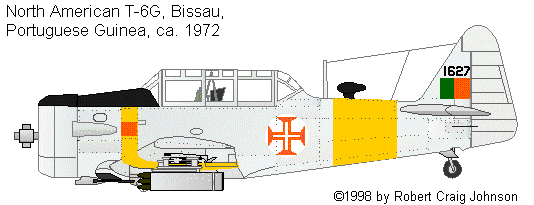
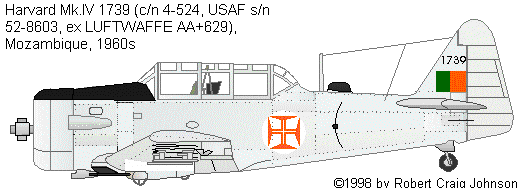
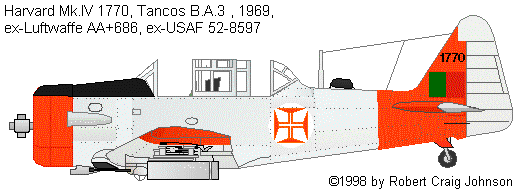
Unlike the French, the Portuguese had to rely heavily on their jet fighters for COIN operations. Portugal had approximately 125 F-84G Thunderjets (serial numbers 5101-5225) and 65 North American F-86F Sabres (5301-5365) on hand when the rebellion began, and it could not afford to buy additional combat aircraft purely for use in the colonies. The F-84Gs were the first to go to Africa. The two squadrons at Air Base 2, in Ota, were transferred to Air Base 9 in Luanda, Angola shortly after the start of hostilities. They remained there for the next 16 years. Detachments occasionally operated in Mozambique as well. When the Thunderjets stood down in 1974, they were the last operational examples of their type in the world.
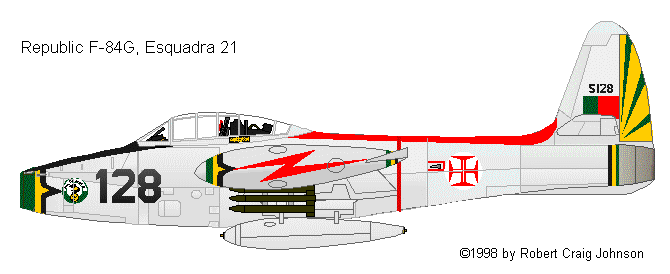
F-86Fs were sent to Guinea-Bissau in 1961. Eight aircraft—5307, 5314, 5322, 5326, 5354, 5356, 5361, and 5362—were sent initially, in "Operation Atlas." One or two others may have followed later. As Detachment 52, they operated out of Bissalanca air base at Bissau in support of army units and naval Fuzileiros (marines). The F-86s flew 577 sorties, using bombs, napalm, and Matra and HVAR rockets. Portugal was secretive about losses, but it appears that they were relatively light. Sabre 5314 was destroyed when it overran the runway during an emergency landing, and 5322 was shot down by ground fire in 1963 (the pilot ejected and was rescued). Many aircraft suffered varying degrees of damage.
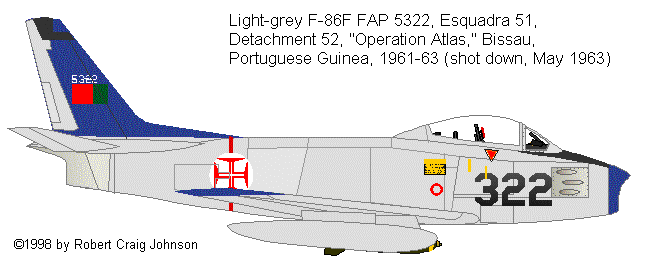
This reliance on their jets placed the Portuguese in an uncomfortable position vis à vis their principle ally, the United States. All the aircraft were American, and all had been supplied under the American military aid programs. The US supplied the aircraft on the understanding that they would be dedicated to NATO for the defense of Europe. By diverting them to the colonies, Portugal was, in American eyes, in breach of contract. Portugal was, moreover, compromising NATO security and embarassing the United States at a time when it was trying to establish good relations with newly independent African states. The US blocked shipments of replacements and spares and kept up a constant barrage of protests and diplomatic pressure. By October 1964, Portugal had to withdraw the Sabres from Bissau. The F-84s were overlooked somehow. Perhaps, having made its point over the Sabres, Washington chose to turn a blind eye. Or possibly the F-84s were so manifestly obsolete that they weren't considered worth worrying about.
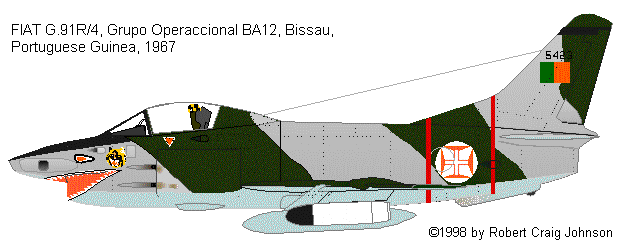
To replace the F-86s in Guinea-Bissau and provide fighter-bombers for Mozambique, the Portuguese obtained the FIAT G.91R/4, a European aircraft with a European engine. The G.91 was a small, light- weight aircraft that could operate from roads or grass fields. It had been developed as the standard tactical fighter-bomber for all NATO air forces, but, in the event, only Germany placed it in service. The R/4 model had originally been earmarked for Greece and Turkey, but both nations had rejected it before delivery. Since 50 Greek aircraft had already been completed, Germany agreed to add them to its order. The R/4s were never really satisfactory in Luftwaffe service, however. They were armed with four .50-cal machine guns rather than the 30-mm DEFA cannon standard on German airplanes, and they had various detail differences that made them hard to support. When Portugal went looking for new fighters, the R/4s were officially assigned as advanced trainers and seldom flown. In 1966, Germany transfered 40 of the aircraft (5401-5440) to Portugal. Many were immediately despatched—still in their Luftwaffe camouflage—to Guinea-Bissau. Others served in Mozambique and, on occasion, in Angola, sporting a new, tropical grey finish.
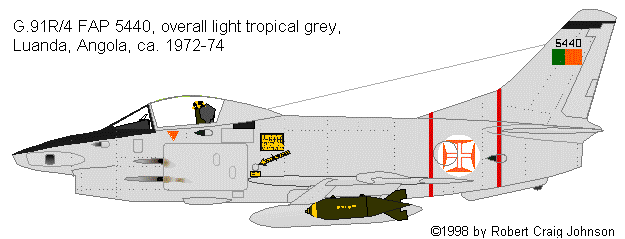
By 1964, both the Harpoons and the F-84s were getting old, and spares were hard to come by. As a replacement, Portugal settled on a by now famous COIN type, the B-26 Invader. Invaders had served with distinction in Laos, Vietnam, and the nearby Congo. But by the time the Portuguese started shopping for them, they were already well past their prime. A rash of wing-spar failures had grounded B-26 fleets world wide, and the corrective, re-sparring programs were at best partial successes. More importnatly, the aircraft had by now become closely associated with clandestine operations and shady arms deals. The mere presence of a B-26 was likely to attract unwelcomepress, customs, and diplomatic attention. Nevertheless, Portugal commissioned various Swiss, French, and American intermediaries to buy aircraft for service in Angola. Aircraft were obtained from various sources, refurbished in the US, in Tucson, AZ, and ferried to Portugal via Canada. The Portuguese air force's central maintenance facility, OGMA, then fitted armament and brought the aircraft up to military standards. The rear cockpit canopy was replaced with a metal fairing, different radios were fitted, and extra fuel tanks were installed in the bomb bay. Several B-26C models were converted to B-type strafers at the same time.

US authorities were at first slow to act against what was essentially an illegal arms-smuggling operation. But they launched an investigation shortly after the seventh aircraft was despatched. There were arrests, questions in the UN, and more bad publicity than Portugal wanted. This, combined with the fact that only seven aircraft had gotten past US Customs, caused the government to give up plans for deploying the B-26 in Angola. Instead, they were used for miscellaneous and experimental duties in metropolitan Portugal. By 1971, however, the deteriorating war situation caused the authorities to reconsider their decision. All available airplanes were desperately needed. Six B-26s were thus sent to Angola to replace the four surviving F-84s. They thus became the only combat airplanes remaining in Luanda. The Invader was generally successful in angola. it had the range for long, armed reconaissance missions from a central base, and it carried an effective armament. They proved reliable, and only one was damaged by ground fire.
While the attack aircraft usually get most of the attention, transport and utility aircraft play, if anything, an even more critical role in counterinsurgency campaigns. The war in Africa was no exception. It placed heavy demands on Portuguese logistics and infrastructure. Transport aircraft were much in demand, given the distances involved and the vulnerability of surface transport to ambush and mines. The 1930s-vintage Ju-52/Amiot AAC-1 formed half of the Portuguese transport fleet as late as 1960, the rest being C-47s. While fiscal realities guaranteed that the bulk of the troops and matériel would have to go out to the colonies by sea no matter what the air force procurement system did. These airplanes were clearly inadequate for the multitude of remaining transport tasks. A weeks-long ocean voyage was not an option for the ever growing numbers of casualties that had to be repatriated. For this purpose, the Portuguese assembled a small fleet of piston-engined DC-6 airliners. Some attempts were made to purchase Boeing 707 jets, but these were blocked by the American government. To replace the Ju-52s in the in-country transport and paratrooping role, the air force purchased twin-boom, Nord Noratlas transports—6 surplus Nord 2502-As purchased in 1960 from the French airline UAT and 6 turbojet-boosted 2501-Fs bought direct from the manufacturer in 1962. The aircraft were immediately despatched to Air Base 9 at Luanda, Angola and Air Base 10 at Beira, Mozambique. Nineteen additional Nord 2501-D aircraft were purchased in 1968, probably from Armée de l'air surplus stocks.
Like the French, the Portuguese quickly saw a need for a light, STOL utility transport in anti-guerilla operations, something larger than the Auster AOP types they already had but smaller than the C-47. The DHC-3 Otter was the preferred solution. It could accomodate a crew of two and ten passengers or a substantial cargo load, and it was one of the types offered through the US Mutual Defense Aid Program (MDAP). But American opposition to Portugal's colonial policy made MDAP funding impossible, and Portugal could not afford the aircraft on its own. Accordingly, the government turned once again to France. The MH1521 Broussard STOL transport was available in large numbers with the end of the Algerian war. It had half the power of the Canadian airplane and half the payload (pilot and five passengers), but it was available at an affordable price. Portugal purchased an initial five, with more planned for later.
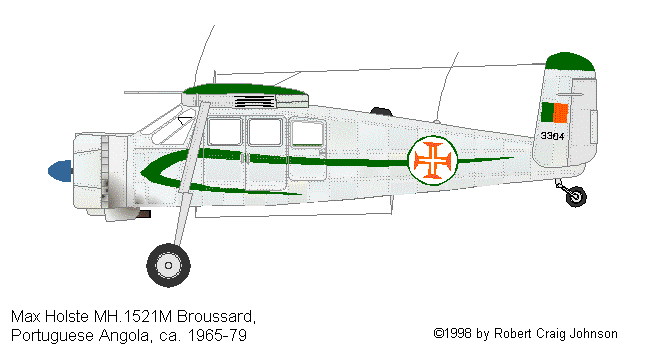
Unfortunately, the Broussards were old and well-worn, as well as cheap. One was lost almost immediately to ground fire over Angola. The others suffered a series of accidents that greatly limited there time in service. All were soon withdrawn. In desperation, the Portuguese turned to the only available STOL type that offered any improvement in payload over the Austers, the Dornier Do-27. The Dornier was essentially a light aircraft. It was powered by a 270-hp Lycoming. Yet, with 200 hp less than the Broussard, it lifted an equivalent payload, 6-8 passengers and crew. It was also rugged, versatile, and, with the simple, horizontally opposed Lycoming engine, economical to operate. After extensive tests, Portugal ordered 16 Do-27Ks, essentially the Luftwaffe's Do27A-4 with a strengthened, wide-track undercarriage, extra fuel tanks, and underwing hard points. These hard points allowed the aircraft to serve in a FAC (Forward Air Control) role with smoke-marker rockets or in the light close-support role with an 18-round pod of 37-mm MATRA SNEB rockets under each wing (interestingly, this rocket was also adapted for use in the standard, infantry bazooka of the Portuguese army). All aircraft were painted in standard Portuguese colors: bare-metal wings and grey fuselage with a white top and a blue cheat line. A second batch of 24 Do-27K-2s was received in 1962, all in overall aluminum finish. Finally, from 1963 on, as the German army and air force began to retire the Do-27, the German government passed many of the aircraft on to Portugal. In all, 106 Do-27A-1, A-3s, A-4s, and B-1s were taken on charge. All retained their German finish, generally NATO-standard Green and grey camouflage, sometimes with bright, day-glo orange cowls or wing tips.
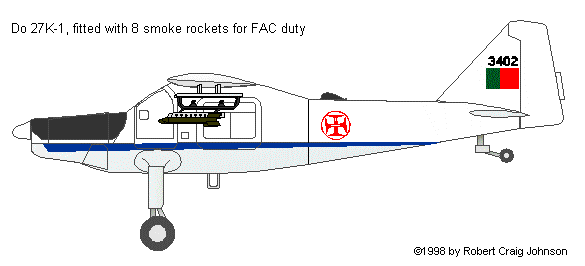
The Dorniers proved popular and highly successful in use, though losses were comparatively heavy. Though vulnerable to ground fire, the rocket-armed Do-27Ks were useful close-support aircraft. But they were in increasingly short supply (11 were lost in action). Several attempts were thus made to arm the German-surplus aircraft, all of which lacked the wing hardpoints that made rocket armament possible. A number of Do-27A-1 and A-4 aircraft were fitted with fuselage racks for two 50-kg bombs and used in action, but the modification does not appear to have been successful enough for gneral adoption. A K-1 was given an experimental door mounting for a 1200 round-per-minute MG42 machine gun and successfully tested using a circling, gunship-style flight path. Though this would have been the easiest way of arming the Do-27As, it was not accepted for service use. In any case, the Do-27s days as a viable combat aircraft were clearly numbered by the late '60s. Light aircraft could not survive in the face of the increasingly common 12.7-mm machine gun fire.
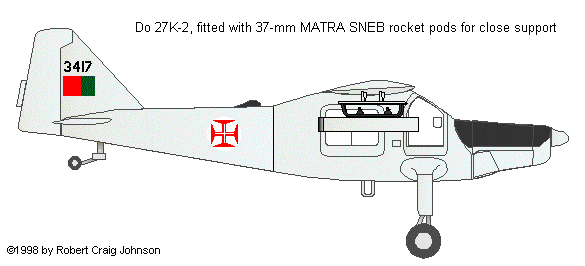
Like all governments in the counterinsurgency era, Portugal made extensive use of helicopters. Both the Sud-Aviation Alouette II and Alouette III saw service in the colonies, primarily in the casualty evacuation role. Gunships were never used, doubtless because budgetary constraints made the limited number of helicopters too valuable to risk in operations that could be handled by fixed-wing airplanes.

The risks of combat flying over the Portuguese colonies escalated dramatically in the late '60s and early '70s, largely because the Soviet SA-7 Strela shoulder-fired missile finally became generally available in the guerilla-controlled hinterland. The SA-7 was a short-range missile designed to home in on the infrared radiation emitted by hot tailpipe of a low-flying jet fighter. The seeker's performance was marginal—it could only attack from the rear, for instance, and could only home on the hot exhaust gas and tailpipe, not on the cooler surrounding metal. It was thus thought that piston-engined aircraft would be largely immune. While the exhausts might well be hotter, they were substantially smaller, were often shrouded by the wing, and were rapidly cooled by air streaming back from the propeller. This assumption proved disastrously wrong. The SA-7 proved extremely capable when it came to detectng the exhaust systems of piston aircraft, and, while high-performance jets could outfly the relatively low-performance Strela if warned in time, piston-engined types were almost always hit before they couldreact. Large aircraft, like the B-26 and PV-2, might survive a hit, because the warhead was small. But Do-27s and T-6s were invariably doomed. Losses among these types increased alarmingly.
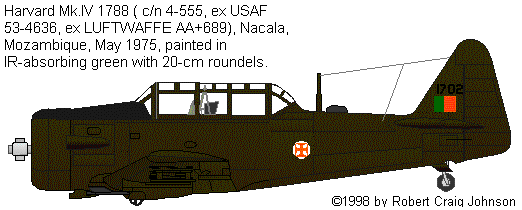
To counter this threat, Portuguese scientists invented a special, "anti-radiation" paint that was supposed to absorb the infrared emissions, smooth out the hot spots, and thus make the aircraft harder to distinguish and harder to lock on to. This dead-flat, olive drab was used in conjunction with tiny, 20-cm, low-visibility, low-reflectivity roundels. Most (but not all) serving Portuguese piston-engined aircraft— including B-26s, T-6s, C-47s, Noratlases, and Do-27s—were repainted to the new standard shortly before Portugal withdrew.


The enormous sacrifices that the Portuguese dictatorship demanded of its subjects proved too much for the people, the economy, and—most importantly—the army. By the 1970s, the Portuguese armed services were largely made up of disaffected conscripts who fiercely opposed continuing the war. Senior commanders became less and less confident of their ability to control their men. General Spinola, the most successful commander in the colonial wars, pressed the government for an immediate ceasefire, to preserve the unity of the army and respect for the chain of command. In 1974, after his entreaties were rebuffed, he and his supporters mounted a coup, and, intentionally or not, launched a revolution that ended authoritarian rule in western Europe.
© 1998 by Robert Craig Johnson.